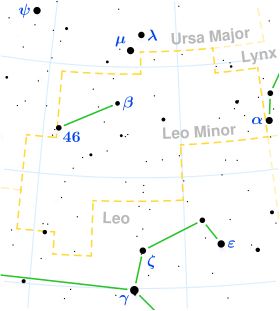10 Leonis Minoris
| Observation data Epoch J2000 Equinox J2000 | |
|---|---|
| Constellation | Leo Minor |
| Right ascension | 09h 34m 13.38197s[1] |
| Declination | 36° 23′ 51.2166″[1] |
| Apparent magnitude (V) | 4.54[2] |
| Characteristics | |
| Spectral type | G8.5III[3] |
| U−B color index | +0.61[4] |
| B−V color index | +0.92[4] |
| Astrometry | |
| Radial velocity (Rv) | -11.94[5] km/s |
| Proper motion (μ) | RA: +6.88[1] mas/yr Dec.: -21.91[1] mas/yr |
| Parallax (π) | 17.63 ± 0.24[1] mas |
| Distance | 185 ± 3 ly (56.7 ± 0.8 pc) |
| Absolute magnitude (MV) | 0.83[6] |
| Details | |
| Mass | 2.54[7] M☉ |
| Radius | 9.20[7] R☉ |
| Luminosity | 51.4[7] L☉ |
| Surface gravity (log g) | 2.93[8] cgs |
| Temperature | 5,099[7] K |
| Metallicity [Fe/H] | -0.04[8] dex |
| Rotational velocity (v sin i) | 4.7[9] km/s |
| Other designations | |
| Database references | |
| SIMBAD | data |
10 Leonis Minoris is a class G8.5III[3] (yellow giant) star in the constellation Leo Minor. Its apparent magnitude is 4.54[2] and it is approximately 185 light years away based on parallax.[1] It is reported as a RS CVn variable with magnitude varying by 0.02 mag.[10]
References
- 1 2 3 4 5 6 Van Leeuwen, F. (2007). "Validation of the new Hipparcos reduction". Astronomy and Astrophysics. 474 (2): 653. arXiv:0708.1752
 . Bibcode:2007A&A...474..653V. doi:10.1051/0004-6361:20078357. Vizier catalog entry
. Bibcode:2007A&A...474..653V. doi:10.1051/0004-6361:20078357. Vizier catalog entry - 1 2 Anderson, E.; Francis, Ch. (2012). "XHIP: An extended hipparcos compilation". Astronomy Letters. 38 (5): 331. arXiv:1108.4971
 . Bibcode:2012AstL...38..331A. doi:10.1134/S1063773712050015. Vizier catalog entry
. Bibcode:2012AstL...38..331A. doi:10.1134/S1063773712050015. Vizier catalog entry - 1 2 Hoffleit, D.; Warren, W. H. (1995). "VizieR Online Data Catalog: Bright Star Catalogue, 5th Revised Ed. (Hoffleit+, 1991)". VizieR On-line Data Catalog: V/50. Originally published in: 1964BS....C......0H. 5050. Bibcode:1995yCat.5050....0H.
- 1 2 Mermilliod, J. C. (2006). "VizieR Online Data Catalog: Homogeneous Means in the UBV System (Mermilliod 1991)". VizieR On-line Data Catalog: II/168. Originally published in: Institut d'Astronomie. 2168. Bibcode:2006yCat.2168....0M.Vizier catalog entry
- ↑ Massarotti, Alessandro; Latham, David W.; Stefanik, Robert P.; Fogel, Jeffrey (2008). "Rotational and Radial Velocities for a Sample of 761 Hipparcos Giants and the Role of Binarity". The Astronomical Journal. 135: 209. Bibcode:2008AJ....135..209M. doi:10.1088/0004-6256/135/1/209.
- ↑ Da Silva, Ronaldo; Milone, André de C.; Rocha-Pinto, Helio J. (2015). "Homogeneous abundance analysis of FGK dwarf, subgiant, and giant stars with and without giant planets". Astronomy & Astrophysics. 580: A24. Bibcode:2015A&A...580A..24D. doi:10.1051/0004-6361/201525770. Vizier catalog entry
- 1 2 3 4 Reffert, Sabine; Bergmann, Christoph; Quirrenbach, Andreas; Trifonov, Trifon; Künstler, Andreas (2015). "Precise radial velocities of giant stars". Astronomy & Astrophysics. 574: A116. arXiv:1412.4634
 . Bibcode:2015A&A...574A.116R. doi:10.1051/0004-6361/201322360. Vizier catalog entry
. Bibcode:2015A&A...574A.116R. doi:10.1051/0004-6361/201322360. Vizier catalog entry - 1 2 Wu, Yue; Singh, H. P.; Prugniel, P.; Gupta, R.; Koleva, M. (2010). "Coudé-feed stellar spectral library – atmospheric parameters". Astronomy & Astrophysics. 525: A71. arXiv:1009.1491
 . Bibcode:2011A&A...525A..71W. doi:10.1051/0004-6361/201015014.
. Bibcode:2011A&A...525A..71W. doi:10.1051/0004-6361/201015014. - ↑ De Medeiros, J. R.; Alves, S.; Udry, S.; Andersen, J.; Nordström, B.; Mayor, M. (2014). "A catalog of rotational and radial velocities for evolved stars". Astronomy & Astrophysics. 561: A126. arXiv:1312.3474
 . Bibcode:2014A&A...561A.126D. doi:10.1051/0004-6361/201220762. Vizier catalog entry
. Bibcode:2014A&A...561A.126D. doi:10.1051/0004-6361/201220762. Vizier catalog entry - ↑ Watson, C. L. (2006). "The International Variable Star Index (VSX)". The Society for Astronomical Sciences 25th Annual Symposium on Telescope Science. Held May 23-25. 25: 47. Bibcode:2006SASS...25...47W.
This article is issued from Wikipedia - version of the 11/17/2016. The text is available under the Creative Commons Attribution/Share Alike but additional terms may apply for the media files.
